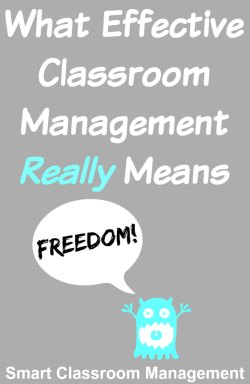
They hear the term and think . . . restricting, confining, constraining.
They think it means to be a rigid disciplinarian who forces students to behave against their will.
So when an administrator makes a remark about the behavior in their classroom, and hints that it needs to be improved, this is what they do.
They throw a lasso around their class and start tightening.
They start barking orders and demands. They start shushing and lecturing. They start raising their voice and aggressively confronting misbehavior.
And although it does seem to make a difference in the moment—an angry voice and a dose of intimidation will indeed quiet an unruly class—overall behavior doesn’t improve.
They’re still battling with students every day. They’re still asking them to stop talking and pushing and calling out without permission. They’re still stressed beyond belief.
The saddest part is that they’ve been led to believe that this is teaching in the 21st century, that like it or not it’s the job they signed up for.
But it isn’t true. Not even close.
Effective classroom management isn’t a no-fun, you-against-them proposition. It isn’t a dampening or suppressing of behavior. And it isn’t uptight, tense, or stressful.
Nor does it ever need to be.
Rather, effective classroom management is a collection of gentle but powerful strategies designed to create an environment that is most conducive to learning and enjoying school.
It’s about trust and influence. It’s about relationships and leadership. It’s about students behaving and giving their best because they want to, not because they’re forced to.
It includes strictness only in a sense that well-defined boundaries of behavior—whose only goal is to protect learning and enjoyment—are faithfully maintained.
Under this true definition, the space within the boundaries represents glorious freedom.
For students, it is the freedom to love school, to thrive academically, and to make lasting friendships without being bullied, bothered, or made fun of.
For teachers, it is the freedom to teach without interference, to develop a passion and appreciation for the profession, and to make an impact that echoes into eternity.
Simply put, effective classroom management is where the desires and fulfillment of both students and teachers meet.
And it is here, at this intersection, where you’ll find us.
At Smart Classroom Management our goal is to show you how to make this true definition a reality in your own classroom. We love teaching and we want you to love it too.
We know firsthand it’s doable for anyone.
Regardless of where you teach or who shows up on your roster, you can create the teaching experience you really want. Don’t let anyone tell you differently.
We’ve heard from hundreds of teachers just like you who have put our simple and honest strategies into action and experienced transformational results.
Although spending time in our archive is a good start, if you’d like a more complete picture of effective classroom management, consider one of our bestselling books.
We also offer 1-on-1 coaching for those who want all of their questions answered and a surefire plan of action going forward.
There is no reason to suffer through another week of talking over students, struggling to get through lessons, or wasting precious learning time.
You can turn it around.
And we can help.
If you haven’t done so already, please join us. It’s free! Click here and begin receiving classroom management articles like this one in your email box every week.

Hi
thanks so much for all the helpful information re classroom management I am very glad and thankful to receive more articales re this and other topics related to this.
best regards!
myrna Canlas
You’re welcome, Myrna!
Michael